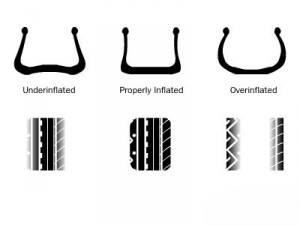Having the correct tire pressure is crucial for driving safety. Incorrect pressure can affect your car’s handling, braking, fuel economy, your comfort while riding and the life of your tires. Tire pressure is measured in pounds per square inch (psi) and each manufacturer recommends the best psi for their vehicles.
Why Does Tire Pressure Change?
Tire pressure (psi) is influenced by a variety of factors including normal air loss through the tire, payload, temperature, and damage to the tire. Tires will naturally lose 1-2 psi per month due to regular wear and tear. Additionally, tire pressure changes with ambient temperature – about 1 psi for every 10-degree change in temperature.
What Happens When Tire Pressure Changes?
Tire pressure that’s too high results in less tire touching the ground. In turn, this creates a harsher ride as well as compromised traction and the ability to stop quickly. A tire overinflated by as much as 6 psi can be damaged more easily when tires run over potholes or debris. Over time, overinflated tires lead to excessive inner tire tread wear, decreasing the overall life of tires.

Overinflated tires decrease traction and cause premature center tread wear. Underinflated tires generate heat and cause premature outer tread wear.
When tire pressure is too low, too much of the tire is in contact with the road. Underinflated tires wear prematurely and have the potential to overheat. An underinflation of only 6 psi may seem insignificant, but actually represents about 20 percent of a tire’s recommended pressure and could lead to tire failure or reduce the tread life by as much as 25 percent. Underinflation actually causes a tire to bend more as it moves, resulting in a build-up of excessive heat, an increase in rolling resistance and a decrease in fuel economy by as much as 5 percent.
How to Ensure Proper Tire Pressure
First things first, learn the recommended tire pressure for your vehicle. Contrary to popular belief, this information is not found on the tires themselves; this number refers to the maximum allowable air pressure, which is often higher than what the manufacturer recommends. Look inside the driver’s door, the glove compartment door or the owner’s manual for the recommended air pressure for your vehicle.
Choose a time of the month to check your tire pressure and stick to it. Associate it with another automotive task, like vacuuming the interior, so you won’t forget. For accuracy, use a high quality tire pressure gauge and check pressure when the tires are at air temperature and haven’t been driven more than a few miles.
Lastly, remember to check all four tires, don’t assume the fourth is fine just because the first three are at recommended pressure. And every now and then, check your spare tire, too, to ensure it’s ready for use.
If you’re uncomfortable checking your own tire pressure, your local new car dealer service center can check and adjust your tire pressure for you.
Checking your tire pressure regularly keeps your tires in top condition and just might save you a little cash now that gas prices are soaring. To get more reassurance for your tires, check out Drive-Sure Road Hazard Tire Protection Benefits.
